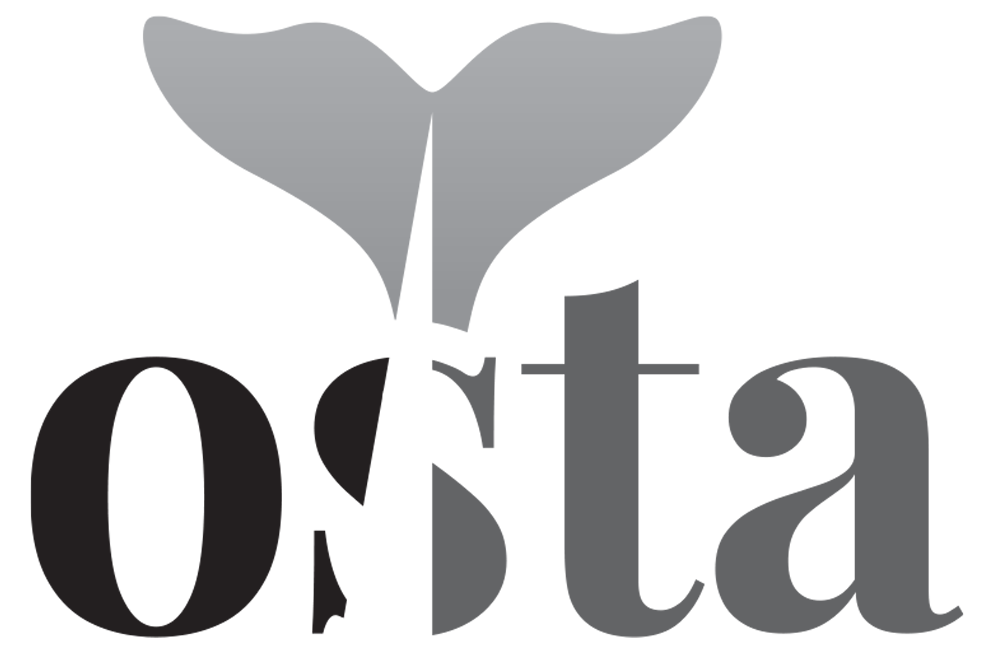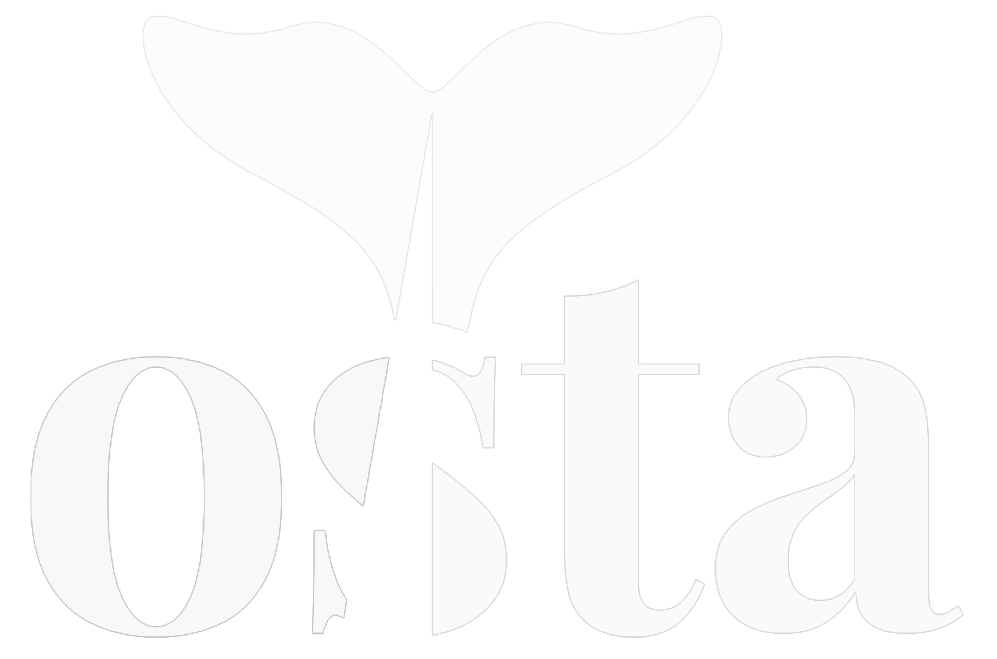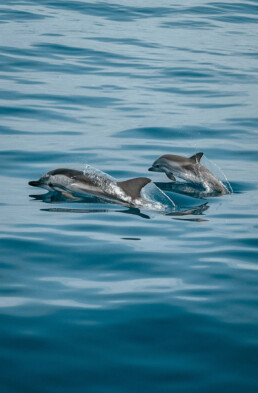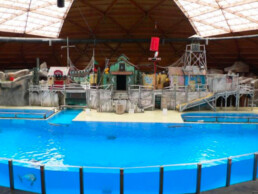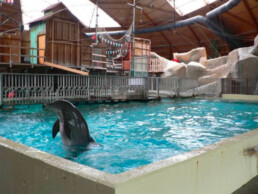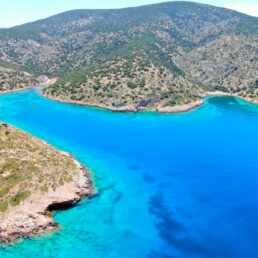Navigating Animal Hardships
Inherent Welfare Concerns at Boudewijn Seapark: Advocating for Relocation and Phased Closure via Breeding Ban
Boudewijn Seapark’s dolphin enclosures have been criticized for their insufficient space and volume, leading to numerous welfare issues such as lack of environmental stimulation, suboptimal behaviors, and health concerns. The optimal scenario proposes relocating the dolphins to reserves such as the Aegean Marine Life Sanctuary in Greece, offering a more natural habitat. An alternative scenario involves modifying Flemish legislation to impose a breeding ban at Boudewijn Seapark, leading to the eventual closure of the dolphinarium. Both scenarios could significantly impact the dolphins’ welfare, enhancing their physical health and mental wellbeing, but also introducing possible stresses due to environmental and social changes. Despite the potential (short-)term negatives, we believe that the long-term benefits of ending dolphin captivity significantly outweigh these issues.
Insufficient Dolphin Enclosure Space
The photos and plans of the basins at Boudewijn Seapark show that the available space (776 m2) and volume (2,895 m2) are very limited for the seven dolphins housed there. [1]
Main basin
Basin in the back
Plan of the dolphinarium
The surface area / volume of the current pools being « sub-optimal » is confirmed in the Dolphin study, commissioned by the Flemish Government in 2021/2022:[2]
‘(…) the pool volume per dolphin at Boudewijn Seapark currently (362m3/dolphin) falls within the “sub-optimal” category in terms of welfare impacts, and to achieve the best welfare score they would have to provide over 700m3/dolphin (…).’
At present, the dolphins at Boudewijn Seapark are given a space of 362 cubic meters each. This can be visualized as a cube with each side measuring just over 7.1 meters. The best welfare score, according to the Dolphin study, equates to each dolphin having a space of 700 cubic meters. This can be visualized as a cube with dimensions of approximately 8.9 meters in length, width, and depth. To imagine this in terms of swimming pool space, picture a pool that is nearly 9 meters wide, 9 meters long, and 9 meters deep. This scientifically determined best welfare score is very limited for a dolphin. In stark contrast, bottlenose dolphins in the wild have been known to cover distances of 160 kilometers daily (at a speed of up to 30 km per hour).[3] The disparity between the natural and captive environments highlights how even the best welfare score in captivity pales in comparison to conditions in the wild.
Dolphin Welfare in Captivity
Animal welfare issues specific to the seven Boudewijn Seapark dolphins, identified in the Dolphin study, include:
- Insufficient volume of basins.
- Lack of environmental stimulation leading to suboptimal behavior.
- Suboptimal or poor affiliative behavior in five of the eight dolphins.
- Suboptimal relationships between the dolphins and trainers without food.
- Daily frustration for the dolphins due to confinement in small holding pens for four hours between trainings.
- Four dolphins showing suboptimal or poor interaction with or use of enrichment material.
In addition to the welfare concerns highlighted in the Dolphin study, further welfare problems exist at Boudewijn Seapark, specifically inherent to the nature of dolphinaria:
- Artificial Living Environment: Dolphins in captivity spend their lives in artificial environments instead of their natural habitats, which negatively impacts their well-being (e.g., eye conditions due to the chemical treatment of water).[4]
- Noise: The loud music and regular, repetitive noise from water pumps and filters cause stress to dolphins, who have excellent hearing and rely heavily on it.[5]
- Limited Space: The constrained space in Boudewijn Seapark’s dolphinarium leads to problems such as abnormal repetitive behavior (stereotypes) and aggression, as also indicated in the Dolphin study.[6]
- Stress: Dolphins are trained by withholding food, so they are hungry enough to perform tricks.[7]
- Health Concerns: Despite improved veterinary care for dolphins in dolphinariums, dolphins often exhibit behavioral and physiological signs of stress and frequently succumb to premature death due to infections or other health conditions. [8]
In the optimal scenario, the dolphins currently residing at the Boudewijn Seapark Dolphinarium would be relocated to a reserve, where they could live out their lives in a more natural environment. To facilitate this, the Flemish Minister of Animal Welfare should initiate discussions to determine the conditions under which such a transfer could take place.
The Dolphin study has identified seven potential reserves that could accommodate the Boudewijn Seapark dolphins. These include the Aegean Marine Life Sanctuary in Greece which is currently in the planning stage, with the University of Toronto and World Animal Protection among its collaborators. Other potential reserves are the Umah Lumbah Centre in Italy and Crete, which has made progress in opening two sanctuaries, and the National Aquarium Baltimore’s Dolphin Sanctuary Project, which could potentially accept the dolphins after mid-2026.
This is where the dolphins from Boudewijn Seapark would reside in the Aegean Marine Life Sanctuary (AMLS) in Greece:
By moving to a reserve, the Boudewijn Seapark dolphins would have the opportunity to live in a setting that closely resembles their natural habitat, providing for their overall well-being and welfare.
Alternative scenario
In an alternative scenario, current Flemish legislation, that bans dolphinariums but offers an exception for the Boudewijn Seapark Dolphinarium in Bruges, could be modified to require a breeding ban for the seven dolphins at the Boudewijn Seapark Dolphinarium. The proposed breeding ban would be part of a phase-out strategy, leading to the closure of the dolphinarium once the existing dolphins pass away.
Contrary to the Dolphin study [9], which implies that a breeding ban could have adverse effects on animal welfare and would prolong the existence of dolphinariums through indefinite breeding, it is argued that a breeding ban would not negatively impact the welfare of dolphins. This position is supported by existing breeding bans in animal reserves, which have shown no adverse effects on the animals. Additionally, our proposal challenges the assumption that dolphins would suffer significantly if they were unable to breed. This counterargument stems from the belief that reproduction is not a prerequisite for a meaningful life. While comprehensive research research on the long-term impact of breeding bans on animal welfare is scarce, existing studies primarily focusing on the short-term health effects suggest that a breeding ban can coincide with a positive welfare state.
Impact if the Optimal Reality is Realized:
7 Animals
7 dolphins
__
Seven dolphins, six females and one male, call the Boudewijn Seapark Dolphinarium home and participate in daily public training sessions. The dolphins are:
– Females: Puck (~58 years), Linda (~48 years), Roxanne (~38 years), Yotta (~25 years), Indy (~21 years), and Moana (~9 years).
– Male: Kite (~18 years).
The welfare of these seven dolphins, and any potential future dolphins, could be significantly affected by both a transfer to a reserve and the implementation of a breeding ban. A reserve offers a larger and more natural environment, enhancing the dolphins’ physical health and mental wellbeing. Such a move could also introduce short-term stress and health risks due to the drastic changes in their environment and social structures. However, we believe that the long-term benefits outweigh these short-term issues.
A breeding ban is seen as a positive strategy, marking a step towards phasing out captivity. While a breeding ban might cause slight disruptions to the dolphins’ natural behaviors and social structures initially, it is ultimately a move towards improving their overall welfare and reducing the number of dolphins born into captivity.
[1] Photos and plans are extracted from the ‘Council for Animal Welfare in Belgium, Considerations on keeping dolphins (Tursiops truncatus) in dolphinariums’ (scientific report, 2010) and ‘Study on keeping dolphins in captivity (‘Dolphin study’)’, written by Dr. Isabella Clegg of Animal Welfare Expertise, April 2021.
[2] Ibid. Dolphin study, Study 1, Welfare study, 31.
[3] Ocean Conservancy, ‘Bottlenose Dolphin’ <https://oceanconservancy.org/wildlife-factsheet/bottlenose-dolphin>.
[4] C. Colitz, M. Walsh, and S. McCulloch, ‘Characterization of Anterior Segment Ophthalmologic Lesions identified in Free-Ranging Dolphins and those under Human Care’(2016) 47 Journal of Zoo and Wildlife Medicine 56-75; Dolphin Study, Welfare study (Study 1) 26 (Two dolphins at Boudewijn Seapark have eye conditions).
[5] L. Couquiaud, Special Issue: Survey of Cetaceans in Captive Care (2005) 31/3 Aquatic Mammals 277-385.
[6] R. Clubb and G.J. Mason, ‘Animal Welfare: Captivity Effects on Wide-Ranging Carnivores’ (2003) 425 Nature 473-474.
[7] N. Stewart, ‘Dolphins in Captivity Endure Seven Stages of Suffering in Their Tragic Lives,’ World Animal Protection, April 14, 2021.
[8] L. Marino et al., ‘The Harmful Effects of Captivity and Chronic Stress on the Well-being of Orcas’ (2019) 35 Journal of Veterinary Behavior 69-82.
[9] Ibid. Dolphin study (n2) Study 1, Welfare study, 37-38.
